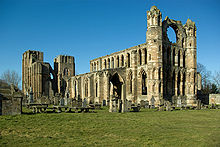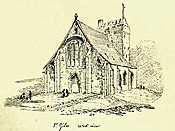
Back كاتدرائيه الجين ARZ Catedral d'Elgin Catalan Katedrála v Elginu Czech Catedral de Elgin Spanish Elgingo katedrala Basque کلیسای جامع الگین Persian Cathédrale d'Elgin French Cattedrale di Elgin Italian Elgin Cathedral Dutch Katedra w Elgin Polish
| Elgin Cathedral | |
|---|---|
 | |
 | |
| Location | Elgin, Moray |
| Country | Scotland |
| Denomination | Catholic |
| History | |
| Authorising papal bull | 10 April 1224 |
| Founded | 1224 (in present position) |
| Founder(s) | Bishop Andreas de Moravia |
| Dedication | The Holy Trinity |
| Dedicated | 19 July 1224 |
| Events | Pre-Reformation
Post-Reformation
|
| Associated people | King Alexander II Alexander Stewart, Earl of Buchan Alexander Gordon, 1st Earl of Huntly John Shanks |
| Architecture | |
| Functional status | Ruin |
| Architectural type | Cathedral |
| Style | Gothic |
| Administration | |
| Diocese | Moray (est. x1114–1127x1131) |
| Deanery | Elgin Inverness Strathspey Strathbogie |
| Clergy | |
| Bishop(s) | (Of significance) Brice de Douglas Andrew de Moravia Alexander Bur Patrick Hepburn |
| Designated | 6 February 1995 |
| Reference no. | SM90142 |
| Category | Ecclesiastical |
Elgin Cathedral is a historic ruin in Elgin, Moray, north-east Scotland. The cathedral, dedicated to the Holy Trinity, was established in 1224 on land granted by King Alexander II outside the burgh of Elgin and close to the River Lossie. It replaced the cathedral at Spynie, 3 kilometres (2 mi) to the north, which was served by a small chapter of eight clerics. By 1226, the new and developing cathedral was staffed with 18 canons increasing to 23 by 1242. A damaging fire in 1270 prompted a significantly enlarged building. It remained unaffected by the Wars of Scottish Independence, but again suffered extensive fire damage in 1390 when attacked by Robert III's brother Alexander Stewart, Earl of Buchan, also known as the Wolf of Badenoch. In 1402, the cathedral precinct again suffered an incendiary attack by the Lord of the Isles followers.
As the cathedral grew, so did the number of clerics and craftsmen. The repairs following the 1270 and 1390 fires resulted in the doubling in length of the choir and the provision of outer aisles to both the nave and choir. Today, some parts of walls reach their full height while others are at foundation level, but the overall cruciform shape is still discernible. A mostly intact octagonal chapter house dates from the major enlargement after the fire of 1270. The gable wall above the double door entrance that links the west towers is nearly complete and was rebuilt after the fire of 1390. It accommodates a large window opening that now only contains stub tracery work and fragments of a large rose window. The transepts and the south aisle of the choir contain recessed and chest tombs with effigies of bishops and knights. The now grass-covered floor bears large flat slabs that mark the positions of early graves. The residences of the dignitaries, canons and chaplains that stood in the chanonry were also destroyed by the fires of 1270, 1390 and 1402 forming part of the reconstruction process. Only the precentor's manse is substantially intact, while two others have been incorporated into private buildings. Both west front towers are mostly complete and were part of the initial construction. A protective wall of massive proportions surrounded the cathedral precinct, but only two small sections have survived. The wall had four access gates but only one, the Pans Port, still exists.
By the time of the Scottish Reformation in 1560, the number of canons had increased to 25. After the Reformation the cathedral was abandoned, and its services transferred to Elgin's parish church of St Giles. After the removal of the lead waterproofing of the roof in 1567, the cathedral fell steadily into decay. The building was still largely intact in 1615, but a winter storm brought down the roof covering the eastern limb. In the spring of 1711, the central steeple above the crossing collapsed, taking the walls of the nave with it. Ownership was transferred from the Church to the Crown in 1689, but that made no difference to the building's continued deterioration. Only in the early years of the 19th century did the Crown begin the conservation process. The structural stabilisation continued until the end of the 20th century, with significant improvements to the two western towers.
- ^ Boardman, Early Stewart Kings, pp. 235–6
© MMXXIII Rich X Search. We shall prevail. All rights reserved. Rich X Search

